A primer to the non-Two-Face stars of Walt Simonson's "The Judas Coin" (mildly NSFW)
For the past couple weeks, I've been working on my review of Walt Simonson's new graphic novel, The Judas Coin, watching my post get increasingly long-winded as I filled it with more scans, tangents, links, gifs, and all manner of distractions until the actual review itself was dwarfed by everything else! The post is currently huge, and I haven't even gotten to the book itself!
How did I manage to pull this off, you ask? Well, because I realized that it was impossible to talk about The Judas Coin without talking about all of the characters involved. One of the biggest hang-ups some readers are having with The Judas Coin is the cast of D-list Silver Age characters who are so obscure here that they didn't even appear on Batman: The Brave and the Bold! And that show had EVERYBODY! Sure, a couple of them appeared on Justice League Unlimited, but I can attest that nobody who saw those episodes remembers those characters if they hadn't already been familiar with them going in. Those were great treats for fans, but generally insufficient intros for n00bs.

So this is "Flower Cowboy," got it.
Personally, I don't think you necessarily need to know anything about them to enjoy Simonson's stories because Simonson is just that good of a storyteller who knows how to play up their archetypical aspects to make them pretty much accessible to everyone. But even still, a bit of familiarity with these characters couldn't hurt. Speaking personally as someone who was at least familiar with most of these characters and completely ignorant about one of them, I enjoyed the story on the first go-round, but I've come to love it even more after researching these characters for the past week!
So before I post (or even write) the review itself, I'd like to examine the characters involved first in their own post, just to give everyone--including me--a crash-course tour of these obscure heroes of yesteryear, and the subsequent attempts to make them relevant in the decades well past their prime! There's a lot of history behind the cut, so grab a snack and let's dig in!
Fittingly, the first two stories feature characters who both debuted in the premiere issue of the original The Brave and the Bold, which wasn't always a team-up book with Batman, but rather focused on classic, swashbuckling historical adventures for young readers who still knew who still recognized names like Errol Flynn and Tyrone Power! Right away, the first cover told you what to expect:
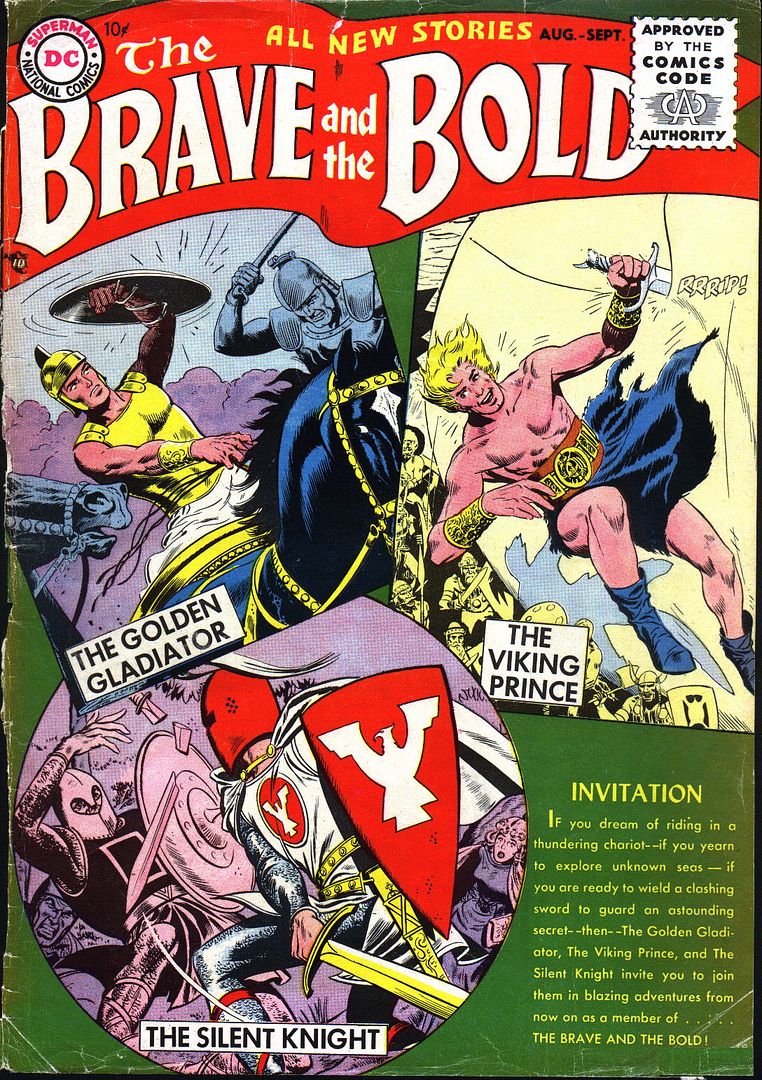
Man, I love that mission statement. It's so quaint, yet it's also such a direct appeal for old-fashioned swashbuckling escapism. Appropriately, that's the tone which Simonson is recapturing with The Judas Coin, making his book a lovingly nostalgic throwback that also seems to take these eras of DC full circle in some ways. One way he does this is through his first story, which focuses on a middle-aged Golden Gladiator in a tale set many years after the events of The Brave and the Bold. His Who's Who entry will tell you everything you need to know.
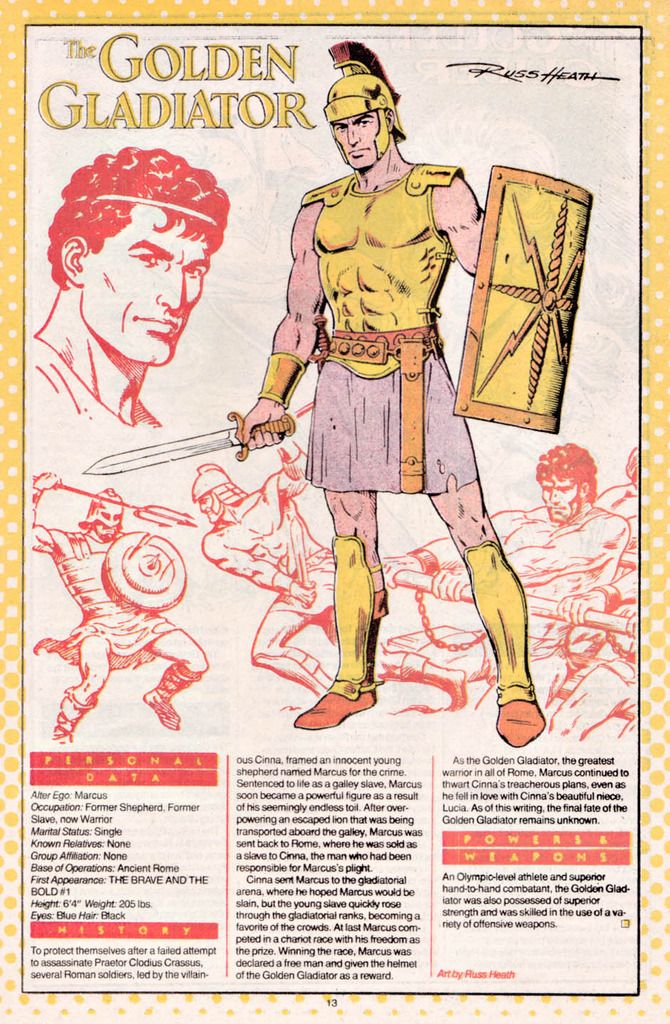
Created by Red Skull co-creator Ed Herron and the great Russ Heath, the Golden Gladiator's entire story arc ran in just six issues before getting the dubious distinction of being the first series dropped from The Brave and the Bold, which his feature getting replaced by Robin Hood while the Viking Prince and the Silent Knight carried on for the next year or two! Aside from the odd cameo here or there, poor Marcus has largely been forgotten, living on primarily through mentions in places like History of the DC Universe and the Zero Hour timeline. Nobody ever even mentions his greatest achievement, which was royally pissing off Attila the Hun:

Also, it's worth noting that Lucia proved herself to be a bit more proactive than the average Silver Age love interest who wasn't Lois Lane
So yeah, when it came to Marcus and the later events of his life, Simonson a lot of blank canvas to work with. In fact, perhaps it's a little too blank. The only real story Marcus had going for him was his origin, the entirety of which was recounted above. From that point on, his other five appearances were all very standard adventure stories that did nothing to further Marcus' rivalry with Cinna or his romance with Lucia. But then, this was a DC Comic in the Silver Age, so what do we expect? The hero has some task to face down, the love interest swoons, the villain gets thwarted and schemes for another day, rinse and repeat.
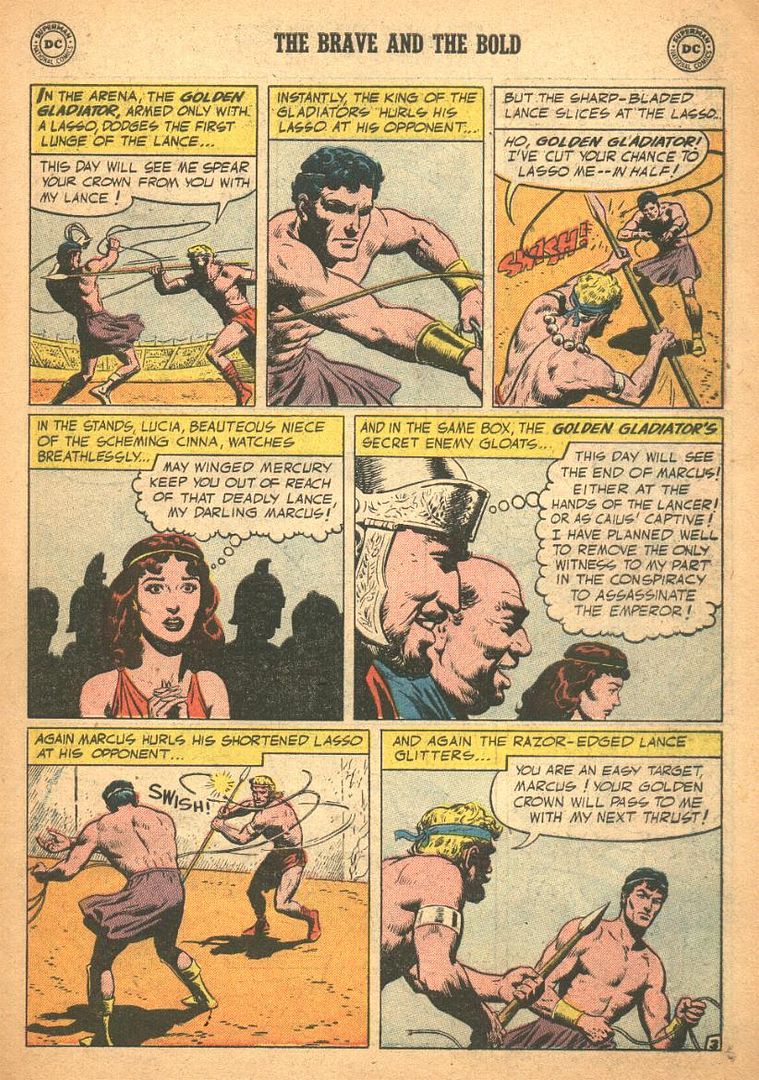
Again, we can't blame him, since that pretty much describes every issue of Superman or Green Lantern from the Silver Age. Who knows how the character might have developed if he'd survived through the Bronze Age and beyond? As it was, Marcus was just another superhero, only from a different time period. This same problem plagues Marcus' co-headliner, who also happens to be the second focus in The Judas Coin. Funny how that works out!
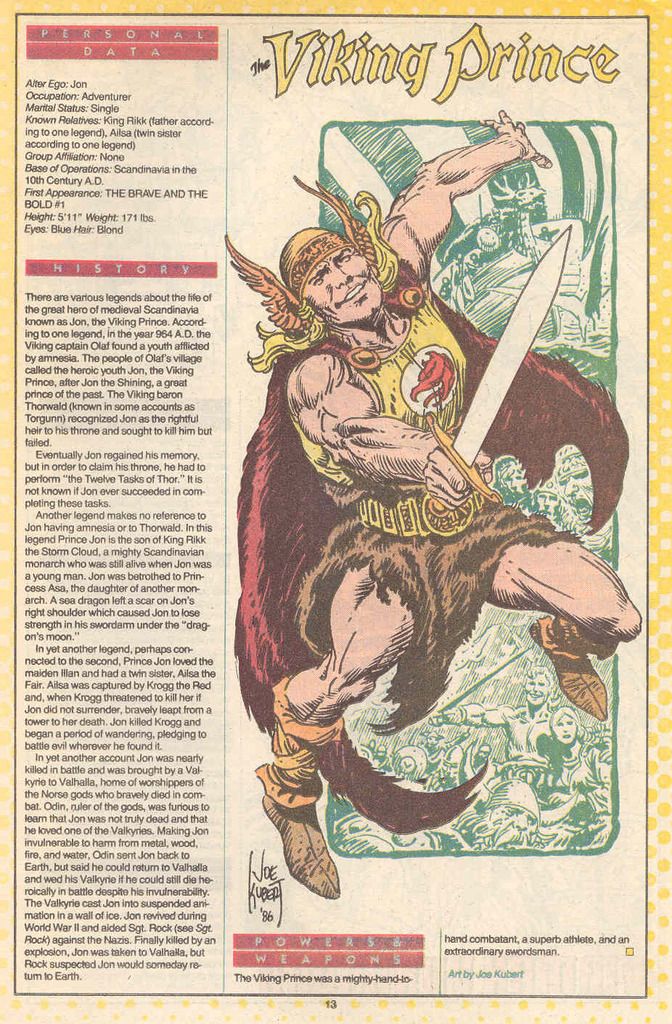
Unlike poor Marcus, Prince Jon here at least had the good fortune to be created by the legendary Sgt. Rock/Enemy Ace team of Robert Kanigher and Joe Kubert, and as such, his early adventures have at least been collected in a single handsome hardcover. Sure, it's now out of print, but that's still better treatment than the first and last characters in this story have gotten! If you'd like a sample of what Kubert's Viking Prince is like, you can read an entire story here at the great classic comics team-up blog, Mail it to Team-Up! God, I love blogs that host entire issues of neat obscure comics, don't you?
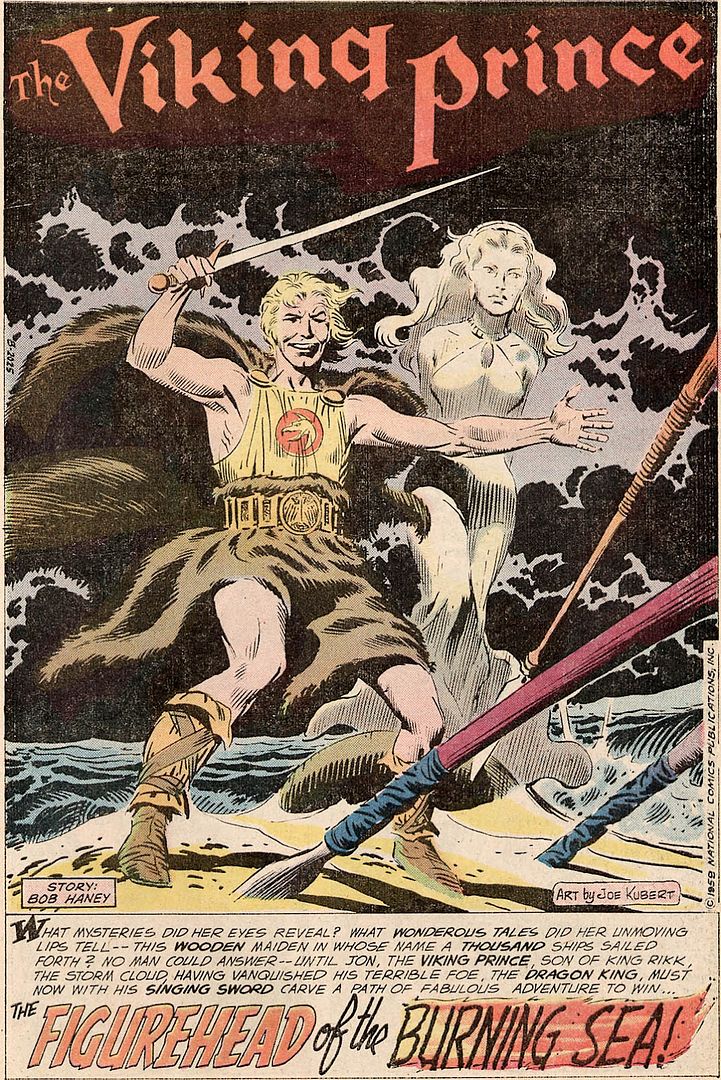
As you can see, the story is pretty straightforward and standalone, and while the hero isn't especially remarkable, it's the art that's the real star. The recently-departed Mr. Kubert is indelibly tied to the Viking Prince, so much so that Justice League Unlimited devoted an entire segment to the character in Kubert style in the episode, To Another Shore (cue to 4:29):
As far as character info dumps go, you could do a lot worse than having it delivered via dramatic reading by Powers Boothe as Gorilla Grodd set to Joe Kubert artwork. Honestly, you could just stop right there. But even in the Kubert lore, the Viking Prince is once of the less famous characters, and he hasn't made many appearances over the years. Actually, before someone brings it up, I should mention that both Jon and the Golden Gladiator both recently starred in a 2008 twelve-part revival of the classic DC title, The War That Time Forgot.
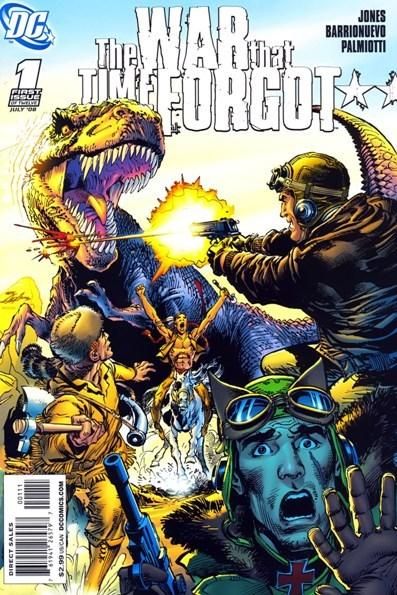
Plus, hey, one of the covers was by--you guessed it--Walt Simonson:
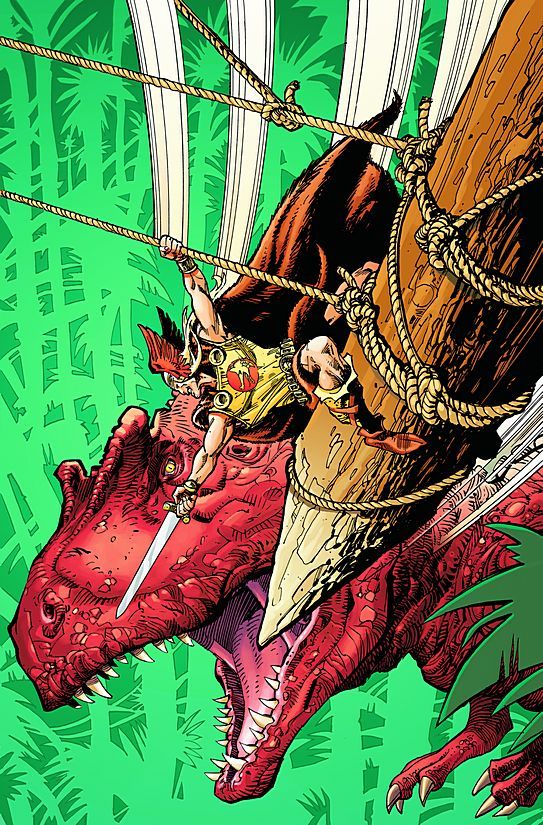
Like pretty much everybody else, I haven't read it, and I'm now curious to know how it was. I mean, it's written by Bruce Jones, whose work over the past fifteen years ranges from "interesting, but flawed" to "Jason Todd as a morphing tentacle monster that barfs acid and also eats people." So while I don't know how he handled Golden Gladiator and Viking Price, I doubt that he could have come close to Simonson's treatment of the characters, especially the Viking Price, seeing as how Walt has experience with Norse-themed characters. And speaking of Walt having experience with characters, that brings us to our third star:

I have to say, of all the origins we've seen thus far, I think Fero's here is by far the most interesting. A Carib Amerindian who is kidnapped into slavery, escapes, and becomes a pirate? That is legitimately cool, especially considering that DC had a tendency to have white guys being better Native Americans than the actual Native Americans. What's more, while he is a criminal and a pirate, he has a solid motivation for who he attacks and why, and the fact that he has more honor and integrity than other pirates makes him a pretty great antihero.

While Simonson gets art credit there, his main contribution to the character was in designing that outfit. the character was actually created by Viking Prince co-creator Robert Kanihger and artist Alex Niño, whose original stories really emphasized the native aspects of the character over the course of their entire run. If you'd like to read the entire original saga of Captain Fear short stories under Niño, Kanihger, and writer Steve Skeates, the great comics blog Diversions of the Groovy Kind has you covered in three posts: his debut, a two-parter, and the last three stories, at the end of which it looked that though Fero was finally going to get a proper (if rather cliche) pirate costume.
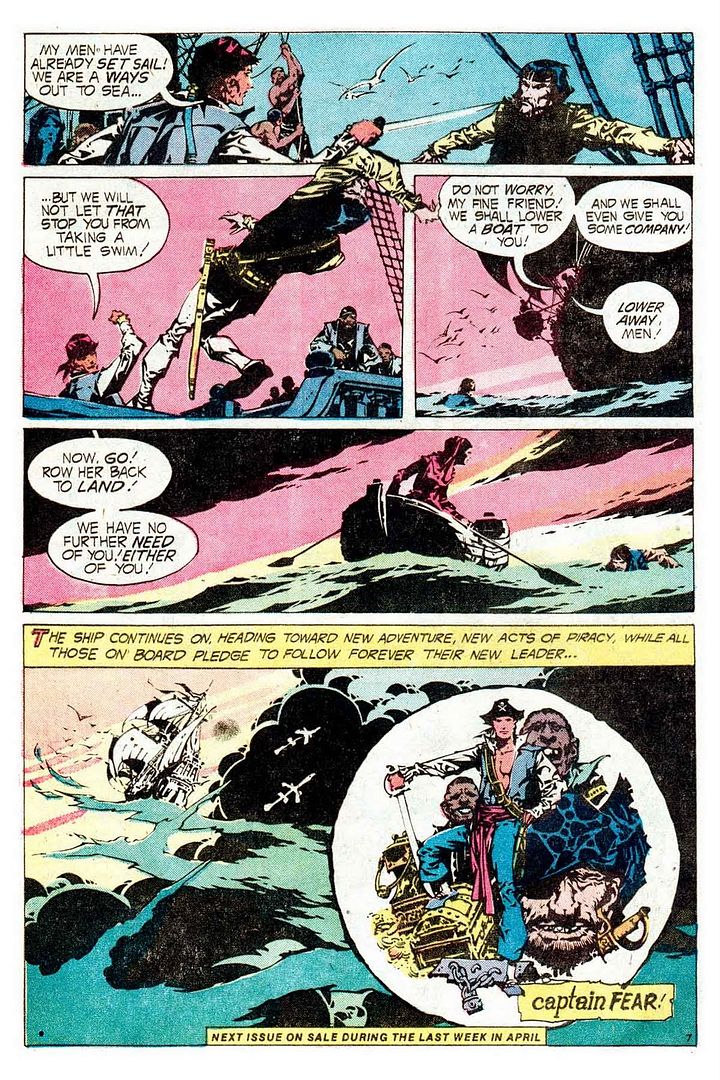
That saga is pretty great stuff, but in the trade paperback DC's The Art of Walter Simonson (which collected a bunch of his shorter DC work), Walt expressed some mixed feelings about the Niño run, calling those stories "beautifully drawn" but "a historical rat's nest" that was littered with anachronisms. Walt set out to correct that mistake when he was hired to draw a grand, tweaked revival of Captain Fear in the pages of Unknown Soldier, with a story written by David Michelinie.
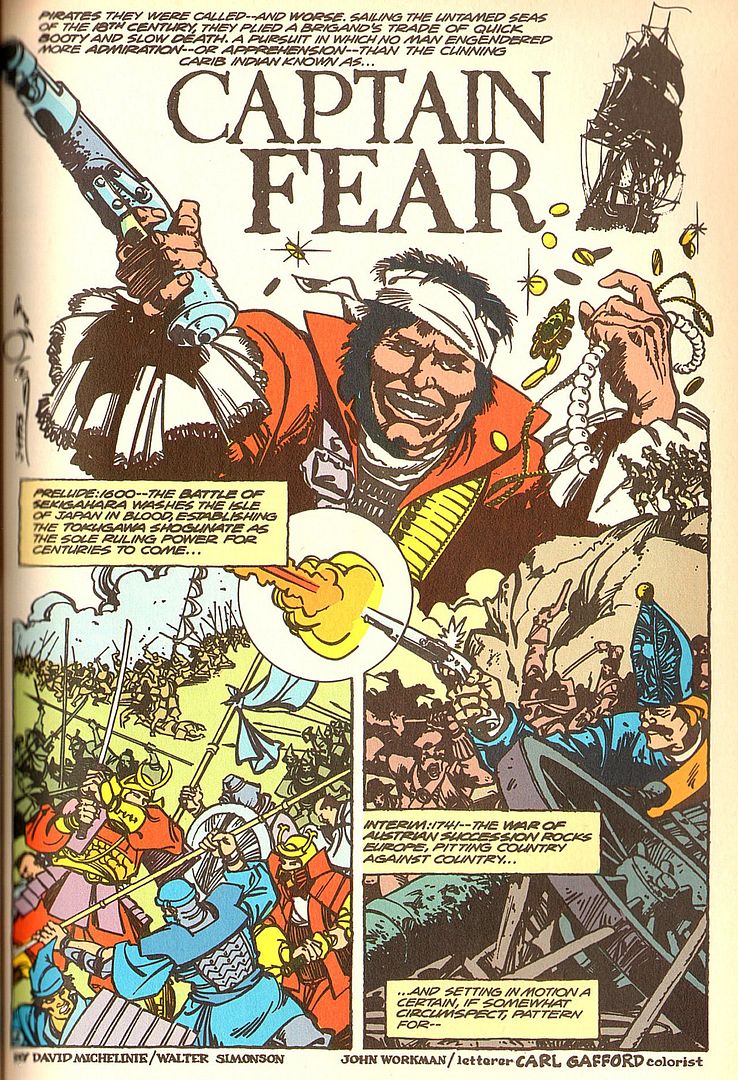
Walt approached this story with boyish enthusiasm, or at least, that's the impression I got when I read his intro to the story in The Art of Walter Simonson. "I have always loved old sailing ships and drawing them in a story has always been one of my ambitions," he said, and as such, "Captain Fear offered the perfect opportunity." He ended up spending nearly four years on the project, over the course of which he purchased "a couple dozen books on old sailing ships" in order to get all of the details straight. For the story itself, he and Michelinie recast the character in the mid-18th century, and then proceeded to cram in as much history as they could. Also, a ninja.

Yeah, unless I'm mistaken, this story is probably the very first example of Pirates VS. Ninjas, wayyyy before the internet and memes became things. So in a way, it's Walt Simonson and David Michelinie who to blame for the fact that I had to sit through my friends' production of Romeo and Juliet done as pirates and ninjas! Well, Simonson is awesome, and Michelinie is partially responsible for my favorite-ever version of Dr. Octopus, so I graciously forgive them. It also doesn't hurt that their makeover of Captain Fear looked great, giving the character a sense of shambling, dashing swashbuckelry that matched the badassness of his origins and personality.
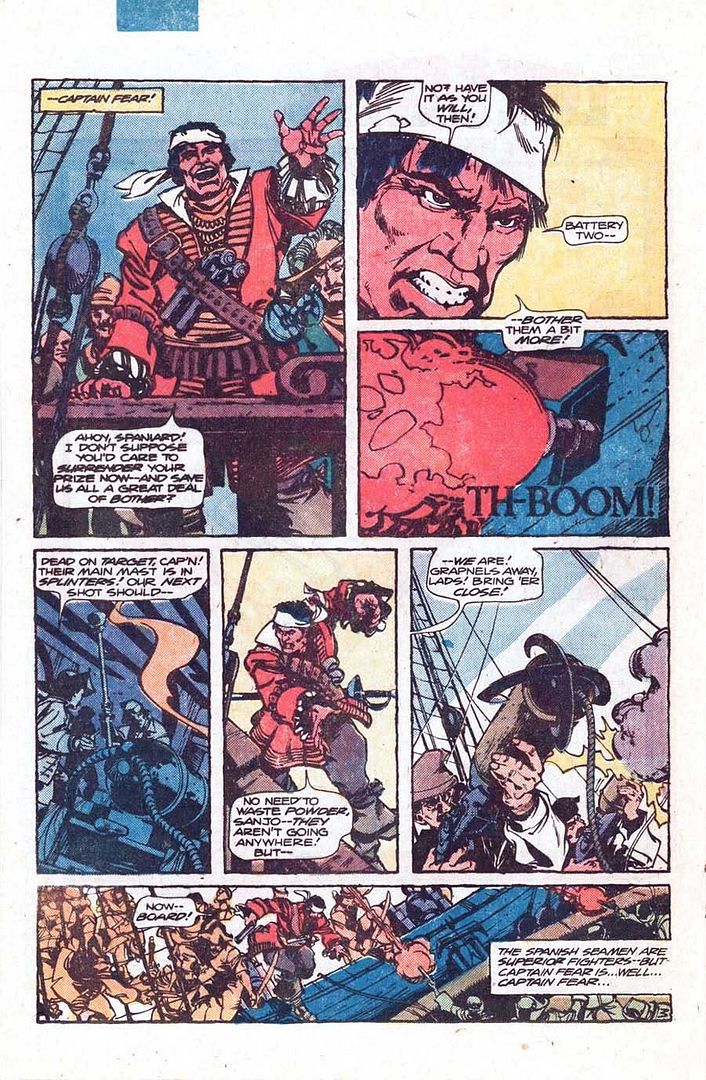
The character then returned to comic book limbo for over a decade until he was given another overhaul in the early 90's, this time at the hands of the great John Ostrander in The Spectre. I haven't read the story myself since many back issues of Ostrander's Spectre are surprisingly difficult to find, but you can get the gist of it over at Captain Fear's wiki page at the DC Database. In the proud tradition of ghost pirates everywhere, Captain Fear's deal was given a supernatural twist, adding a new level of horror and tragedy to the vengeful antihero.
Unfortunately for the character--but fortunately for lovers of the ridiculous--this directly gave way to his appearance in Brian Azzarello and Cliff Chiang's sublimely silly satire, Doctor Thirteen, where he was an unrecognizable cartoon of a Spanish pirate. Well, Which is all well and good until you remember that the Spaniards were the ones who slaughtered his people and enslaved him, but hey, when has crucial canon ever gotten in the way of glorious ridiculousness?
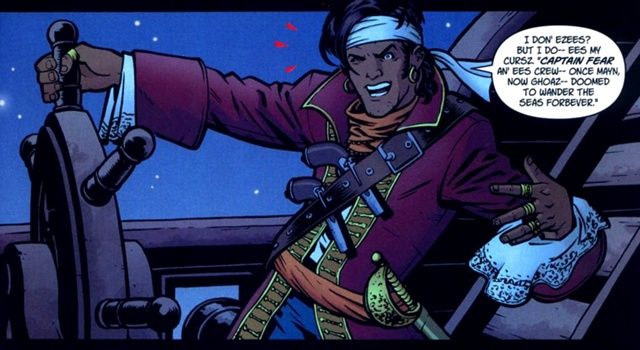
I am ashamed to admit that this was my introduction to the character, and much as I want to see it as sacrilege, I still have affection for this cracktacular take. That said, it's worth noting that the reason Azzarello used Captain Fear in the first place was because he was given a list of D-list characters that DC had absolutely no use for even as canon fodder during their Infinite Crisis/52 events. The stars of Azzarello's book--including Fero, Anthro, and Andrew Bennett from I, Vampire--were call characters who weren't even considered important enough to kill off. Think about that. Much as I dislike Azz's current work, I respected him like hell for Doctor Thirteen, which was a love letter to and defense of obscure characters.
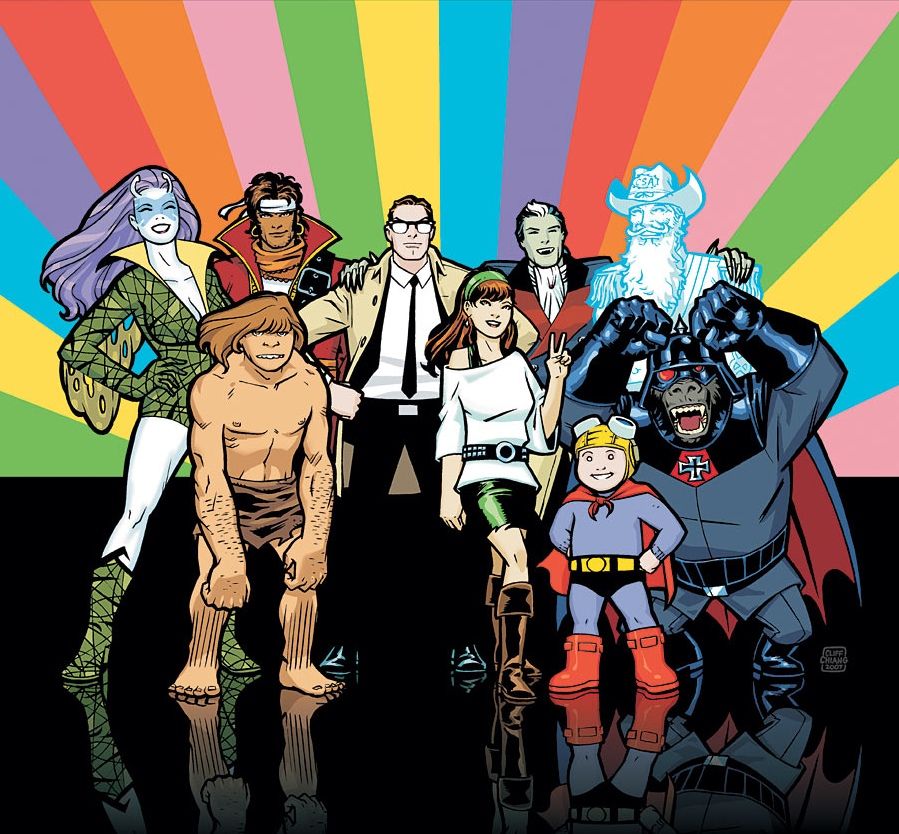
Still, his point doesn't entirely hold water if he's going to turn the character into something silly and unrecognizable, because it implies that the character wasn't good enough in the first place. Can you bring a character back to his roots and still make him interesting to modern audiences? That's the challenge facing Walt Simonson in The Judas Coin, not just with Captain Fear but with all of these characters. In some ways, the next character is both the easiest and the hardest one to pull off: easiest because his fans know how great he can be, and hardest because... well, just look at him:
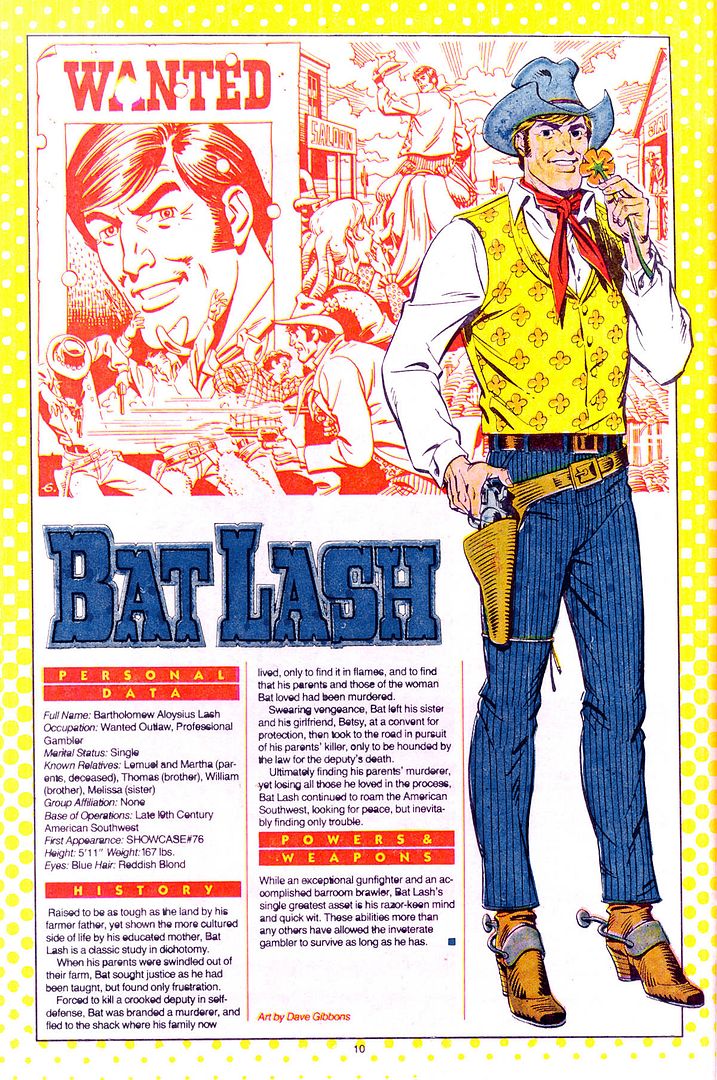
While I'd never read a full-length comic with Bat Lash until recently, I've always had an affection for this character, and not just because he was co-created by Sergio Aragones. Sure, he looks ridiculous, the kind of character who seems like an easy target for cheap mockery from the likes of, say, Conan O'Brien, but how could I not love the idea of a dandy fop cowboy? When I read his first appearance (the entirely to which you can read here!), my hopes for being delighted were confirmed:
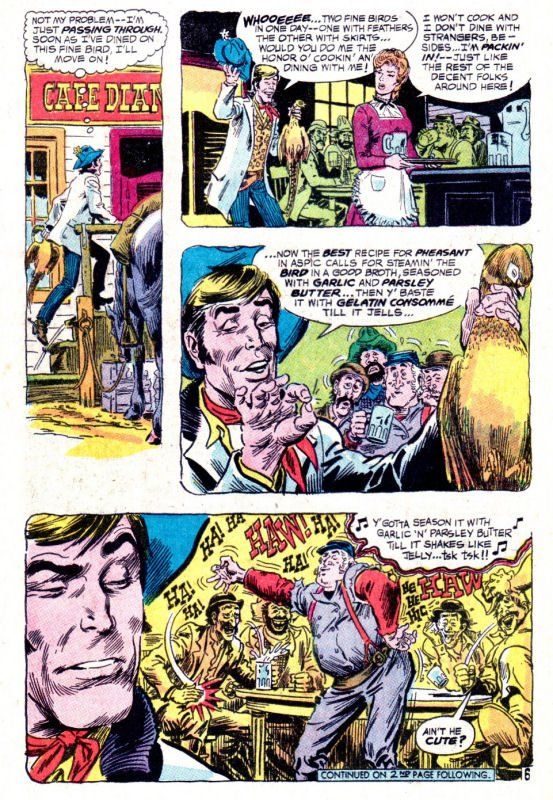
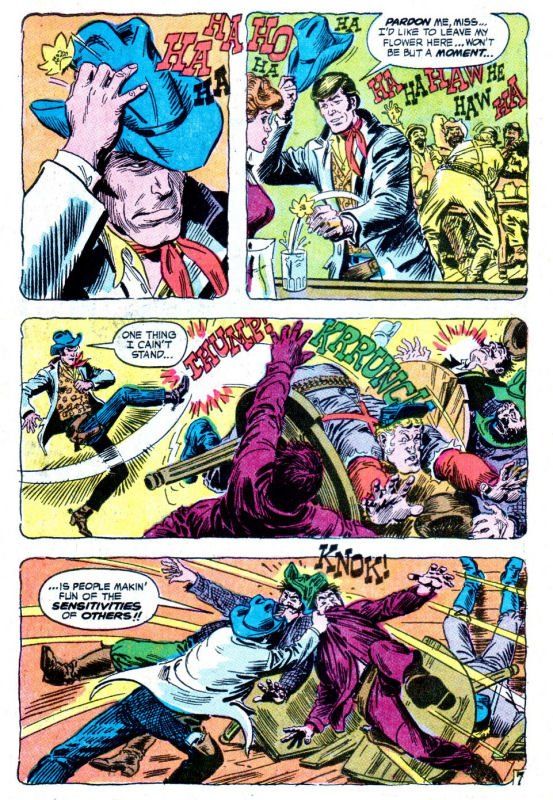
Yeah, I like this guy a lot. While he can brawl and shoot, but he more likely to rely on his charisma, charm, and wits, and he does it all with a flair. Of all the obscure characters in The Judas Coin, Bat Lash is probably the most well known, and he's made a couple notable-ish appearances recently, including getting a new mini-series written by Aragones, drawn by the great (and recently departed) John Servern, and it even sported covers by--guess who?--Walt Simonson:
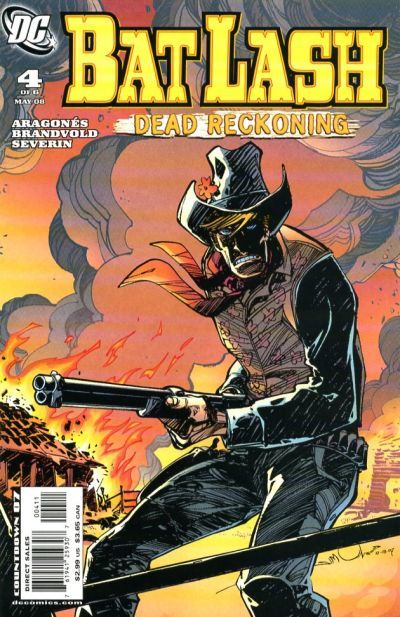
Unfortunately, what I'd read of the series lacked the fun and flair of the Bat Lash I'd hoped to see. If anyone's read it and liked it, do let me know so I can give it another chance, but even the covers made the character look more grizzled and standard. He's a guy with a fanciful vest and a flower in his hat, for god's sake! No amount of fires and scowls can hide that! He the kind of guy who should be ready with a one-liner and a smirk for all occasions!
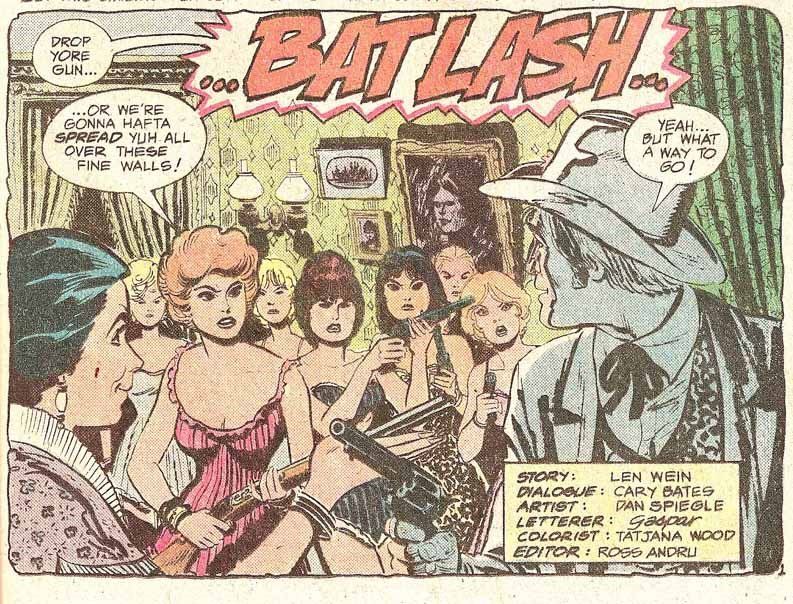
In some ways, I think Bat Lash's best treatment recently was his appearance in Justice League Unlimited, where he was voiced by Ben Browder of Farscape, Stargate SG-1, and the recent western cyborg episode of Doctor Who. As a mega-huge fan of Farscape back in the day, I dare say this might have helped endear me to the character. The whole episode is worth watching (Peter MacNicol as Chronos! Eee!), but for Bat's intro, cue to 7:56:
It's a great episode and he's good in it, but man, I would have loved to have seen a full, proper Bat Lash misadventure in Batman: The Brave and the Bold. Alas, we only got Jonah Hex, and while I love Jonah dearly, Bat's one of those rare characters who are actually fun. Of course, it's funny that Walt used Bat instead of Jonah for The Judas Coin, seeing as how the western story led direction into the "present day" segment with Two-Face! We were THIS close to a story with both Jonah Hex and Harvey Dent in some capacity! Ah, well.
Since we all know Harvey, let's skip to the fifth and final obscure character in The Judas Coin, who just happens to be the one character I'd never heard of before. In fact, when I read the book, I just assumed was an original creation for this book due to the connection that Simonson has to another DC hero with the same name! For this character, we must venture to THE YEEEEEAARRRR TWO THOUSAND... SEVENTY!
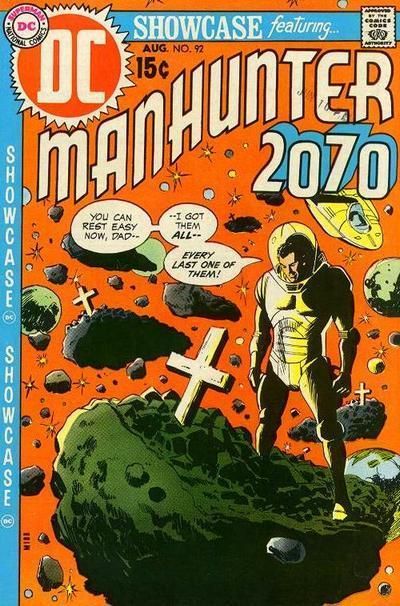
Considering that Manhunter 2070's first appearance predates the legendary Goodwin/Simonson reinvention of the character by three years, I'm not certain if this character is even meant to be a legacy hero or if he just happens to share the same name. There's very little information about the character out there, and DC thought so little of him that he didn't even get a Who's Who entry! Not even one of the small, half-page entries like Captain Fear got! I mean, sure, the original character only appeared three times by that point, but geez, they've given profiles to other characters who have had less! So what's this guy's deal, anyway?

Created by Mike Sekowsky, Manhunter 2070 is a space bounty hunter who goes after space pirates ("You know, like pirates! But in SPACE!"), and who spends his off-time in the company of two sexy space ladies. Though it's not spelled out that they're sleeping together, it's possible that Manhunter 2070 is the only superhero in a polyamorous relationship, something which Simonson hints at again in his own take on the character. But it's not all fun and games with Manhunter 2070, whose real name is Starker, and whose past motivates him more than money or fame:

So yeah, as it turns out, Starker's father was a space miner who was killed by space claim-jumpers, who in turn kidnapped little Starker and kept him into a galley slave. A space galley slave. Basically, his origin is a mash-up of western tropes with a smattering of seafaring tropes, but it's in the future and some of the familiar roles are now played by robots and aliens. Not that I'm picking on that idea, since that was the concept that's given birth to everything from Star Trek to Blake's 7 to Firefly, not to mention my beloved Farscape. Also, notice how this is the third character to have slavery in his origin! That connection never comes up in The Judas Coin, but it's a strange one to have, and it makes me wonder why that was such an influential concept to the DC adventure writers of the Silver Age.
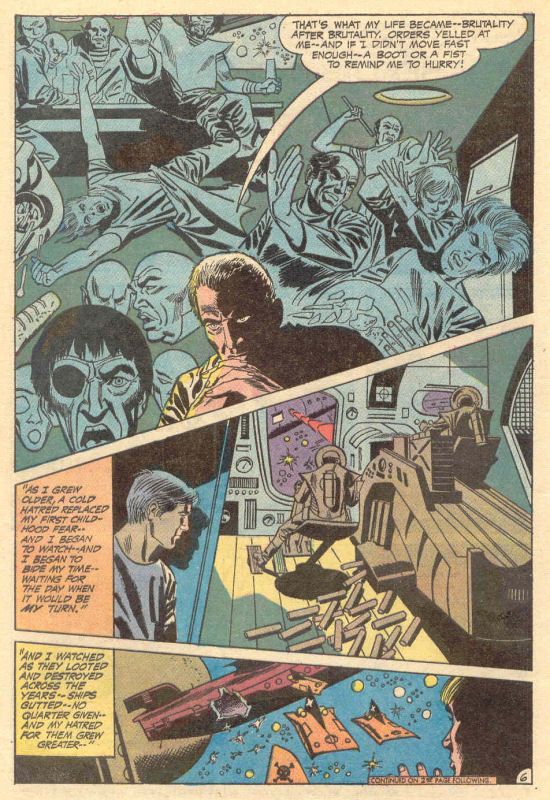
Having escaped and slaughtered his pirate captors, Starker now dedicates his life to hunting down space criminals for personal reasons over profit. There's a lot of potential for to explore in such a character. Is he an altruist, trying to prevent others from suffering as he had, or does he just have a vendetta against criminals of any stripe? It's never explained, as Starker's third and last original appearance ended on a cliffhanger before he was promptly forgotten by DC.
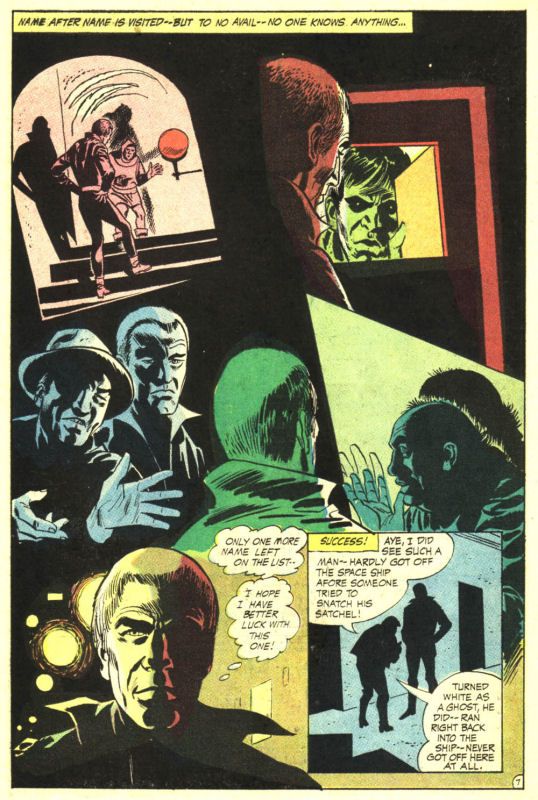
In this appearance, he went looking for a criminal who has reported to be hiding on a planet where, 1.) everyone had green skin, and 2.) everyone was a thief, because the entire planet's society is based around thievery. They hold theft up to be as honorable as the Klingons do with battle, and the very worst of the "Greenies" are the ones with red hair, as Starker himself learned the hard way:
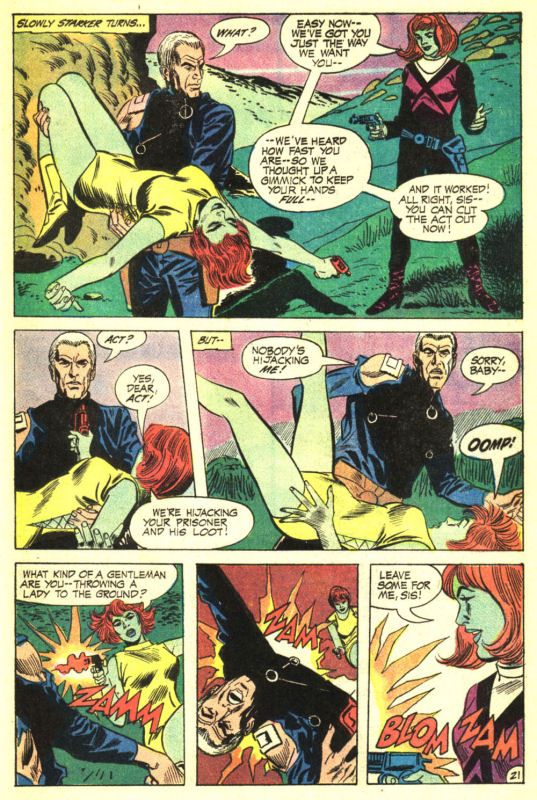
Now you know why the issue was titled "Never Trust a Red-Haired Greenie!" The red-haired Greenie girls knock out Starker and leave him for dead, on that cliffhanger note, Starker's short-lived series was cancelled. The issue was accompanied by one of those editorial notes urging readers to let them know if they wanted more Manhunter 2070, so apparently, no one did. As such, Starker's story was left hanging for forty-two years until Simonson came alone with The Judas Coin, which finally wraps up the loose ends for the five or six people who remember the original stories!
But that wasn't the only appearance of Starker between then and now, which brings us to Twilight. No, not the sparkly vampire books, thank god, I mean the 1990 prestige format mini-series by DC by Howard Chaykin (who, coincidentally, wrote the introduction of The Art of Walter Simonson and even collaborated on Walt's Orion series!) and the masterful José Luis García-López (who seriously deserved his own issue of Solo). Their Twilight was like an unholy combination of Watchmen's mentality of superheroes with Darwyn Cooke's The New Frontier's nostalgia, all of which resulted in a gritty, cynical, revisionist take on the space-faring DC heroes of the Silver Age. Also, it's brilliant.

While I'm normally beyond weary of "everything you know is WRONG!" when it comes to darkening up formerly fun and colorful characters, Twilight is a genuine masterpiece, featuring some of Chaykin and García-López's very best work. But then, I say that as someone who doesn't have any particular affection for the old Strange Adventures comics, nor for characters like Tommy Tomorrow, Space Cabbie, or the Star Rovers. Pretty much, it's a fantastic story is you don't care about those characters, or at least, don't mind seeing them changed into ugly, unlikable, unrecognizable versions, all of whom either wallow in various shades of gray morality or revel in pure evil douchebaggery.
Yeah, it's one of the most purely "Post-Watchmen" comics ever made, but it pulls off that task admirably with a masterwork of comics sci-fi, and poor Starker doesn't come off too well. For one thing, absolutely nothing about his background comes up, nor is he even a bounty hunter. Given the full name of "Jon Starker" (or "John," depending on the issue), he a former mercenary turned washed-up drunk and embarrassment to his asshole brother, Star Hawkins. Oh, and instead of romancing two sexy ladies, this Starker is a robosexual.
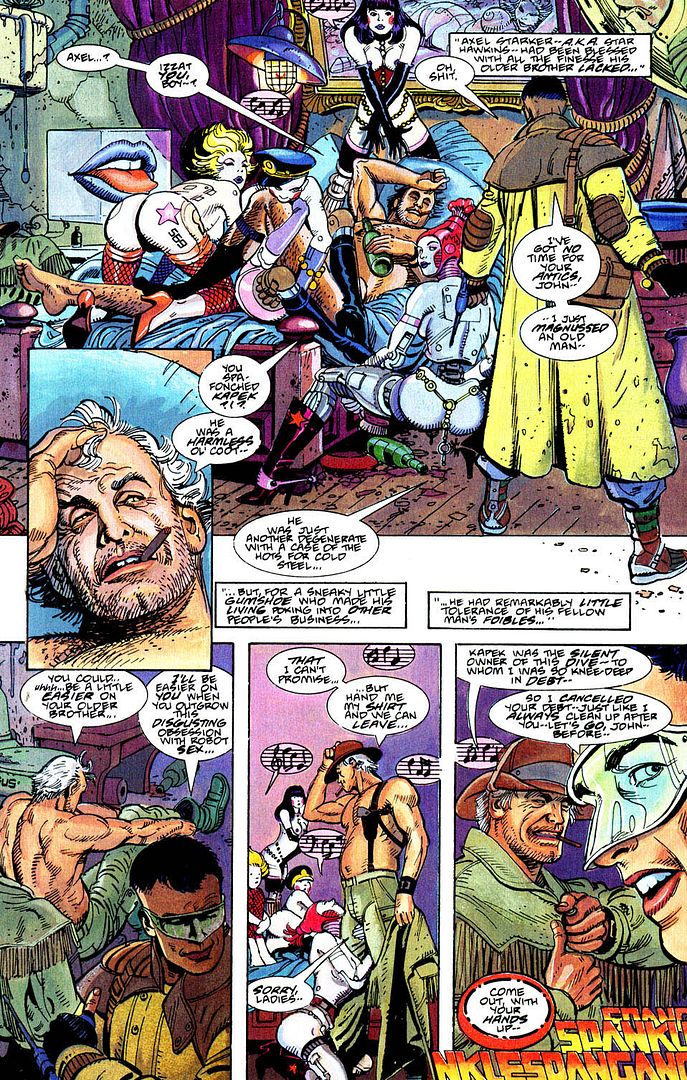
I did mention that this comic was written by Howard Chaykin, right? Over the course of the story, Starker pines after Ilda, his brother's lady-bot assistant, who in turn pines after Star, who in turns treats them both with utter contempt. Starker eventually falls into such a deep hole of self-loathing, heartache, and despair that he hires himself out as a legbreaker and murderer for local criminals, killing innocents and drowning himself a bottle. By the end of the story, he's dying and he talks his brother into merging his body with Ilda's, and thus the two become a bizarre androgynous cyborg engine of destruction. I think there's a lesson to be learned from all this:
Man, when I put it that way, this story sounds really awful and stupid, but I promise you that it all works in context. It's just kind of a shame that this tribute to the forgotten spacefaring characters of old should, much like Azzarrello's story, revive the characters by completely changing everything about them save for the names. Hell, if Chaykin really wanted to tell a hard-boiled, gritty, deeply cynical take on Manhunter 2070, he could EASILY have found that in the character's origins and motivations! And hell, the gambling, cynicism, and sexy stuff was already intact with the character, all of which would have been a perfect fit for Chaykin shortly after his brilliant work on American Flagg! Oh well, I lament that missed opportunity almost as much as I lament the fact that very few people have actually read Twilight, so it's well worth seeking out.
But even still, it's not the same Starker, and it's not the real Manhunter 2070. For that, we still had to wait for Walt Simonson to come along. What's funny is that I suspect that he and Chaykin (and other older creators such as Darwyn Cooke and Bruce Jones) were coming from similar places, seeing as how they're peers and all, and must certainly have grown up reading and treasuring those stories of old. If nothing else, they'd held onto their memories of these stories and these characters long after fandom and even DC itself has swept them under the rug, deeming them too unimportant to even kill off for cheap shock value.
While this past decade has shown us just how poisonous Silver Age nostalgia can be to DC Comics, I still can't help but find that nostalgia kind of beautiful when it comes from someone like Walt. There's something so purely comics about it all, something that can only be found amongst the truly passionate and geeky among us, something that keeps us directly connected with our inner children, even as we now see them through adult lenses. Those thoughts were in the back of my mind the entire time I read The Judas Coin, and it's one major reason why I enjoyed it for more reasons than just the stories themselves. But the stories were great too, so I'll finally get to those next time, in my proper actual review!
By the way, would anybody be able to provide scans from The Judas Coin? I don't have a scanner at present, and while I have several of Simonson's sketches, there are some parts that I really want to actually show those of you who aren't able to get the book immediately. Obviously, the Two-Face section especially takes priority, especially the last few pages. The climactic moment was ambiguous enough that it got me and Henchgirl into a briefly-heated debate over how we interpreted it, so I want to run it by you guys and see what you make of it.
If I have to settle for taking a blurry photo from my iPhone camera, I will, dammit! But nobody wants that! So be a pal and help your old buddy Hef out, if you can!
How did I manage to pull this off, you ask? Well, because I realized that it was impossible to talk about The Judas Coin without talking about all of the characters involved. One of the biggest hang-ups some readers are having with The Judas Coin is the cast of D-list Silver Age characters who are so obscure here that they didn't even appear on Batman: The Brave and the Bold! And that show had EVERYBODY! Sure, a couple of them appeared on Justice League Unlimited, but I can attest that nobody who saw those episodes remembers those characters if they hadn't already been familiar with them going in. Those were great treats for fans, but generally insufficient intros for n00bs.

So this is "Flower Cowboy," got it.
Personally, I don't think you necessarily need to know anything about them to enjoy Simonson's stories because Simonson is just that good of a storyteller who knows how to play up their archetypical aspects to make them pretty much accessible to everyone. But even still, a bit of familiarity with these characters couldn't hurt. Speaking personally as someone who was at least familiar with most of these characters and completely ignorant about one of them, I enjoyed the story on the first go-round, but I've come to love it even more after researching these characters for the past week!
So before I post (or even write) the review itself, I'd like to examine the characters involved first in their own post, just to give everyone--including me--a crash-course tour of these obscure heroes of yesteryear, and the subsequent attempts to make them relevant in the decades well past their prime! There's a lot of history behind the cut, so grab a snack and let's dig in!
Fittingly, the first two stories feature characters who both debuted in the premiere issue of the original The Brave and the Bold, which wasn't always a team-up book with Batman, but rather focused on classic, swashbuckling historical adventures for young readers who still knew who still recognized names like Errol Flynn and Tyrone Power! Right away, the first cover told you what to expect:

Man, I love that mission statement. It's so quaint, yet it's also such a direct appeal for old-fashioned swashbuckling escapism. Appropriately, that's the tone which Simonson is recapturing with The Judas Coin, making his book a lovingly nostalgic throwback that also seems to take these eras of DC full circle in some ways. One way he does this is through his first story, which focuses on a middle-aged Golden Gladiator in a tale set many years after the events of The Brave and the Bold. His Who's Who entry will tell you everything you need to know.

Created by Red Skull co-creator Ed Herron and the great Russ Heath, the Golden Gladiator's entire story arc ran in just six issues before getting the dubious distinction of being the first series dropped from The Brave and the Bold, which his feature getting replaced by Robin Hood while the Viking Prince and the Silent Knight carried on for the next year or two! Aside from the odd cameo here or there, poor Marcus has largely been forgotten, living on primarily through mentions in places like History of the DC Universe and the Zero Hour timeline. Nobody ever even mentions his greatest achievement, which was royally pissing off Attila the Hun:

Also, it's worth noting that Lucia proved herself to be a bit more proactive than the average Silver Age love interest who wasn't Lois Lane
So yeah, when it came to Marcus and the later events of his life, Simonson a lot of blank canvas to work with. In fact, perhaps it's a little too blank. The only real story Marcus had going for him was his origin, the entirety of which was recounted above. From that point on, his other five appearances were all very standard adventure stories that did nothing to further Marcus' rivalry with Cinna or his romance with Lucia. But then, this was a DC Comic in the Silver Age, so what do we expect? The hero has some task to face down, the love interest swoons, the villain gets thwarted and schemes for another day, rinse and repeat.

Again, we can't blame him, since that pretty much describes every issue of Superman or Green Lantern from the Silver Age. Who knows how the character might have developed if he'd survived through the Bronze Age and beyond? As it was, Marcus was just another superhero, only from a different time period. This same problem plagues Marcus' co-headliner, who also happens to be the second focus in The Judas Coin. Funny how that works out!

Unlike poor Marcus, Prince Jon here at least had the good fortune to be created by the legendary Sgt. Rock/Enemy Ace team of Robert Kanigher and Joe Kubert, and as such, his early adventures have at least been collected in a single handsome hardcover. Sure, it's now out of print, but that's still better treatment than the first and last characters in this story have gotten! If you'd like a sample of what Kubert's Viking Prince is like, you can read an entire story here at the great classic comics team-up blog, Mail it to Team-Up! God, I love blogs that host entire issues of neat obscure comics, don't you?

As you can see, the story is pretty straightforward and standalone, and while the hero isn't especially remarkable, it's the art that's the real star. The recently-departed Mr. Kubert is indelibly tied to the Viking Prince, so much so that Justice League Unlimited devoted an entire segment to the character in Kubert style in the episode, To Another Shore (cue to 4:29):
As far as character info dumps go, you could do a lot worse than having it delivered via dramatic reading by Powers Boothe as Gorilla Grodd set to Joe Kubert artwork. Honestly, you could just stop right there. But even in the Kubert lore, the Viking Prince is once of the less famous characters, and he hasn't made many appearances over the years. Actually, before someone brings it up, I should mention that both Jon and the Golden Gladiator both recently starred in a 2008 twelve-part revival of the classic DC title, The War That Time Forgot.

Plus, hey, one of the covers was by--you guessed it--Walt Simonson:

Like pretty much everybody else, I haven't read it, and I'm now curious to know how it was. I mean, it's written by Bruce Jones, whose work over the past fifteen years ranges from "interesting, but flawed" to "Jason Todd as a morphing tentacle monster that barfs acid and also eats people." So while I don't know how he handled Golden Gladiator and Viking Price, I doubt that he could have come close to Simonson's treatment of the characters, especially the Viking Price, seeing as how Walt has experience with Norse-themed characters. And speaking of Walt having experience with characters, that brings us to our third star:

I have to say, of all the origins we've seen thus far, I think Fero's here is by far the most interesting. A Carib Amerindian who is kidnapped into slavery, escapes, and becomes a pirate? That is legitimately cool, especially considering that DC had a tendency to have white guys being better Native Americans than the actual Native Americans. What's more, while he is a criminal and a pirate, he has a solid motivation for who he attacks and why, and the fact that he has more honor and integrity than other pirates makes him a pretty great antihero.

While Simonson gets art credit there, his main contribution to the character was in designing that outfit. the character was actually created by Viking Prince co-creator Robert Kanihger and artist Alex Niño, whose original stories really emphasized the native aspects of the character over the course of their entire run. If you'd like to read the entire original saga of Captain Fear short stories under Niño, Kanihger, and writer Steve Skeates, the great comics blog Diversions of the Groovy Kind has you covered in three posts: his debut, a two-parter, and the last three stories, at the end of which it looked that though Fero was finally going to get a proper (if rather cliche) pirate costume.

That saga is pretty great stuff, but in the trade paperback DC's The Art of Walter Simonson (which collected a bunch of his shorter DC work), Walt expressed some mixed feelings about the Niño run, calling those stories "beautifully drawn" but "a historical rat's nest" that was littered with anachronisms. Walt set out to correct that mistake when he was hired to draw a grand, tweaked revival of Captain Fear in the pages of Unknown Soldier, with a story written by David Michelinie.

Walt approached this story with boyish enthusiasm, or at least, that's the impression I got when I read his intro to the story in The Art of Walter Simonson. "I have always loved old sailing ships and drawing them in a story has always been one of my ambitions," he said, and as such, "Captain Fear offered the perfect opportunity." He ended up spending nearly four years on the project, over the course of which he purchased "a couple dozen books on old sailing ships" in order to get all of the details straight. For the story itself, he and Michelinie recast the character in the mid-18th century, and then proceeded to cram in as much history as they could. Also, a ninja.

Yeah, unless I'm mistaken, this story is probably the very first example of Pirates VS. Ninjas, wayyyy before the internet and memes became things. So in a way, it's Walt Simonson and David Michelinie who to blame for the fact that I had to sit through my friends' production of Romeo and Juliet done as pirates and ninjas! Well, Simonson is awesome, and Michelinie is partially responsible for my favorite-ever version of Dr. Octopus, so I graciously forgive them. It also doesn't hurt that their makeover of Captain Fear looked great, giving the character a sense of shambling, dashing swashbuckelry that matched the badassness of his origins and personality.

The character then returned to comic book limbo for over a decade until he was given another overhaul in the early 90's, this time at the hands of the great John Ostrander in The Spectre. I haven't read the story myself since many back issues of Ostrander's Spectre are surprisingly difficult to find, but you can get the gist of it over at Captain Fear's wiki page at the DC Database. In the proud tradition of ghost pirates everywhere, Captain Fear's deal was given a supernatural twist, adding a new level of horror and tragedy to the vengeful antihero.
Unfortunately for the character--but fortunately for lovers of the ridiculous--this directly gave way to his appearance in Brian Azzarello and Cliff Chiang's sublimely silly satire, Doctor Thirteen, where he was an unrecognizable cartoon of a Spanish pirate. Well, Which is all well and good until you remember that the Spaniards were the ones who slaughtered his people and enslaved him, but hey, when has crucial canon ever gotten in the way of glorious ridiculousness?

I am ashamed to admit that this was my introduction to the character, and much as I want to see it as sacrilege, I still have affection for this cracktacular take. That said, it's worth noting that the reason Azzarello used Captain Fear in the first place was because he was given a list of D-list characters that DC had absolutely no use for even as canon fodder during their Infinite Crisis/52 events. The stars of Azzarello's book--including Fero, Anthro, and Andrew Bennett from I, Vampire--were call characters who weren't even considered important enough to kill off. Think about that. Much as I dislike Azz's current work, I respected him like hell for Doctor Thirteen, which was a love letter to and defense of obscure characters.

Still, his point doesn't entirely hold water if he's going to turn the character into something silly and unrecognizable, because it implies that the character wasn't good enough in the first place. Can you bring a character back to his roots and still make him interesting to modern audiences? That's the challenge facing Walt Simonson in The Judas Coin, not just with Captain Fear but with all of these characters. In some ways, the next character is both the easiest and the hardest one to pull off: easiest because his fans know how great he can be, and hardest because... well, just look at him:

While I'd never read a full-length comic with Bat Lash until recently, I've always had an affection for this character, and not just because he was co-created by Sergio Aragones. Sure, he looks ridiculous, the kind of character who seems like an easy target for cheap mockery from the likes of, say, Conan O'Brien, but how could I not love the idea of a dandy fop cowboy? When I read his first appearance (the entirely to which you can read here!), my hopes for being delighted were confirmed:


Yeah, I like this guy a lot. While he can brawl and shoot, but he more likely to rely on his charisma, charm, and wits, and he does it all with a flair. Of all the obscure characters in The Judas Coin, Bat Lash is probably the most well known, and he's made a couple notable-ish appearances recently, including getting a new mini-series written by Aragones, drawn by the great (and recently departed) John Servern, and it even sported covers by--guess who?--Walt Simonson:

Unfortunately, what I'd read of the series lacked the fun and flair of the Bat Lash I'd hoped to see. If anyone's read it and liked it, do let me know so I can give it another chance, but even the covers made the character look more grizzled and standard. He's a guy with a fanciful vest and a flower in his hat, for god's sake! No amount of fires and scowls can hide that! He the kind of guy who should be ready with a one-liner and a smirk for all occasions!

In some ways, I think Bat Lash's best treatment recently was his appearance in Justice League Unlimited, where he was voiced by Ben Browder of Farscape, Stargate SG-1, and the recent western cyborg episode of Doctor Who. As a mega-huge fan of Farscape back in the day, I dare say this might have helped endear me to the character. The whole episode is worth watching (Peter MacNicol as Chronos! Eee!), but for Bat's intro, cue to 7:56:
It's a great episode and he's good in it, but man, I would have loved to have seen a full, proper Bat Lash misadventure in Batman: The Brave and the Bold. Alas, we only got Jonah Hex, and while I love Jonah dearly, Bat's one of those rare characters who are actually fun. Of course, it's funny that Walt used Bat instead of Jonah for The Judas Coin, seeing as how the western story led direction into the "present day" segment with Two-Face! We were THIS close to a story with both Jonah Hex and Harvey Dent in some capacity! Ah, well.
Since we all know Harvey, let's skip to the fifth and final obscure character in The Judas Coin, who just happens to be the one character I'd never heard of before. In fact, when I read the book, I just assumed was an original creation for this book due to the connection that Simonson has to another DC hero with the same name! For this character, we must venture to THE YEEEEEAARRRR TWO THOUSAND... SEVENTY!

Considering that Manhunter 2070's first appearance predates the legendary Goodwin/Simonson reinvention of the character by three years, I'm not certain if this character is even meant to be a legacy hero or if he just happens to share the same name. There's very little information about the character out there, and DC thought so little of him that he didn't even get a Who's Who entry! Not even one of the small, half-page entries like Captain Fear got! I mean, sure, the original character only appeared three times by that point, but geez, they've given profiles to other characters who have had less! So what's this guy's deal, anyway?

Created by Mike Sekowsky, Manhunter 2070 is a space bounty hunter who goes after space pirates ("You know, like pirates! But in SPACE!"), and who spends his off-time in the company of two sexy space ladies. Though it's not spelled out that they're sleeping together, it's possible that Manhunter 2070 is the only superhero in a polyamorous relationship, something which Simonson hints at again in his own take on the character. But it's not all fun and games with Manhunter 2070, whose real name is Starker, and whose past motivates him more than money or fame:

So yeah, as it turns out, Starker's father was a space miner who was killed by space claim-jumpers, who in turn kidnapped little Starker and kept him into a galley slave. A space galley slave. Basically, his origin is a mash-up of western tropes with a smattering of seafaring tropes, but it's in the future and some of the familiar roles are now played by robots and aliens. Not that I'm picking on that idea, since that was the concept that's given birth to everything from Star Trek to Blake's 7 to Firefly, not to mention my beloved Farscape. Also, notice how this is the third character to have slavery in his origin! That connection never comes up in The Judas Coin, but it's a strange one to have, and it makes me wonder why that was such an influential concept to the DC adventure writers of the Silver Age.

Having escaped and slaughtered his pirate captors, Starker now dedicates his life to hunting down space criminals for personal reasons over profit. There's a lot of potential for to explore in such a character. Is he an altruist, trying to prevent others from suffering as he had, or does he just have a vendetta against criminals of any stripe? It's never explained, as Starker's third and last original appearance ended on a cliffhanger before he was promptly forgotten by DC.

In this appearance, he went looking for a criminal who has reported to be hiding on a planet where, 1.) everyone had green skin, and 2.) everyone was a thief, because the entire planet's society is based around thievery. They hold theft up to be as honorable as the Klingons do with battle, and the very worst of the "Greenies" are the ones with red hair, as Starker himself learned the hard way:

Now you know why the issue was titled "Never Trust a Red-Haired Greenie!" The red-haired Greenie girls knock out Starker and leave him for dead, on that cliffhanger note, Starker's short-lived series was cancelled. The issue was accompanied by one of those editorial notes urging readers to let them know if they wanted more Manhunter 2070, so apparently, no one did. As such, Starker's story was left hanging for forty-two years until Simonson came alone with The Judas Coin, which finally wraps up the loose ends for the five or six people who remember the original stories!
But that wasn't the only appearance of Starker between then and now, which brings us to Twilight. No, not the sparkly vampire books, thank god, I mean the 1990 prestige format mini-series by DC by Howard Chaykin (who, coincidentally, wrote the introduction of The Art of Walter Simonson and even collaborated on Walt's Orion series!) and the masterful José Luis García-López (who seriously deserved his own issue of Solo). Their Twilight was like an unholy combination of Watchmen's mentality of superheroes with Darwyn Cooke's The New Frontier's nostalgia, all of which resulted in a gritty, cynical, revisionist take on the space-faring DC heroes of the Silver Age. Also, it's brilliant.

While I'm normally beyond weary of "everything you know is WRONG!" when it comes to darkening up formerly fun and colorful characters, Twilight is a genuine masterpiece, featuring some of Chaykin and García-López's very best work. But then, I say that as someone who doesn't have any particular affection for the old Strange Adventures comics, nor for characters like Tommy Tomorrow, Space Cabbie, or the Star Rovers. Pretty much, it's a fantastic story is you don't care about those characters, or at least, don't mind seeing them changed into ugly, unlikable, unrecognizable versions, all of whom either wallow in various shades of gray morality or revel in pure evil douchebaggery.
Yeah, it's one of the most purely "Post-Watchmen" comics ever made, but it pulls off that task admirably with a masterwork of comics sci-fi, and poor Starker doesn't come off too well. For one thing, absolutely nothing about his background comes up, nor is he even a bounty hunter. Given the full name of "Jon Starker" (or "John," depending on the issue), he a former mercenary turned washed-up drunk and embarrassment to his asshole brother, Star Hawkins. Oh, and instead of romancing two sexy ladies, this Starker is a robosexual.

I did mention that this comic was written by Howard Chaykin, right? Over the course of the story, Starker pines after Ilda, his brother's lady-bot assistant, who in turn pines after Star, who in turns treats them both with utter contempt. Starker eventually falls into such a deep hole of self-loathing, heartache, and despair that he hires himself out as a legbreaker and murderer for local criminals, killing innocents and drowning himself a bottle. By the end of the story, he's dying and he talks his brother into merging his body with Ilda's, and thus the two become a bizarre androgynous cyborg engine of destruction. I think there's a lesson to be learned from all this:
Man, when I put it that way, this story sounds really awful and stupid, but I promise you that it all works in context. It's just kind of a shame that this tribute to the forgotten spacefaring characters of old should, much like Azzarrello's story, revive the characters by completely changing everything about them save for the names. Hell, if Chaykin really wanted to tell a hard-boiled, gritty, deeply cynical take on Manhunter 2070, he could EASILY have found that in the character's origins and motivations! And hell, the gambling, cynicism, and sexy stuff was already intact with the character, all of which would have been a perfect fit for Chaykin shortly after his brilliant work on American Flagg! Oh well, I lament that missed opportunity almost as much as I lament the fact that very few people have actually read Twilight, so it's well worth seeking out.
But even still, it's not the same Starker, and it's not the real Manhunter 2070. For that, we still had to wait for Walt Simonson to come along. What's funny is that I suspect that he and Chaykin (and other older creators such as Darwyn Cooke and Bruce Jones) were coming from similar places, seeing as how they're peers and all, and must certainly have grown up reading and treasuring those stories of old. If nothing else, they'd held onto their memories of these stories and these characters long after fandom and even DC itself has swept them under the rug, deeming them too unimportant to even kill off for cheap shock value.
While this past decade has shown us just how poisonous Silver Age nostalgia can be to DC Comics, I still can't help but find that nostalgia kind of beautiful when it comes from someone like Walt. There's something so purely comics about it all, something that can only be found amongst the truly passionate and geeky among us, something that keeps us directly connected with our inner children, even as we now see them through adult lenses. Those thoughts were in the back of my mind the entire time I read The Judas Coin, and it's one major reason why I enjoyed it for more reasons than just the stories themselves. But the stories were great too, so I'll finally get to those next time, in my proper actual review!
By the way, would anybody be able to provide scans from The Judas Coin? I don't have a scanner at present, and while I have several of Simonson's sketches, there are some parts that I really want to actually show those of you who aren't able to get the book immediately. Obviously, the Two-Face section especially takes priority, especially the last few pages. The climactic moment was ambiguous enough that it got me and Henchgirl into a briefly-heated debate over how we interpreted it, so I want to run it by you guys and see what you make of it.
If I have to settle for taking a blurry photo from my iPhone camera, I will, dammit! But nobody wants that! So be a pal and help your old buddy Hef out, if you can!